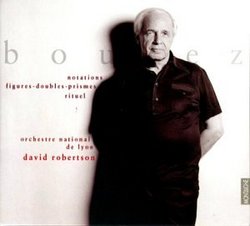| All Artists: Boulez, Robertson Orch Nat'l De Lyon Title: Rituel in Memoriam / Notations 1-4,7 / Figures Members Wishing: 1 Total Copies: 0 Label: Disques Montaigne Release Date: 7/15/2003 Genre: Classical Styles: Historical Periods, Modern, 20th, & 21st Century, Symphonies Number of Discs: 1 SwapaCD Credits: 1 UPC: 822186821633 |
Search - Boulez, Robertson Orch Nat'l De Lyon :: Rituel in Memoriam / Notations 1-4,7 / Figures
 | Boulez, Robertson Orch Nat'l De Lyon Rituel in Memoriam / Notations 1-4,7 / Figures Genre: Classical
|
Larger Image |
CD DetailsSimilar CDs |
CD ReviewsRobertson steps up to the podium and reveals a splendid take Christopher Culver | 09/02/2006 (4 out of 5 stars) "On this Naive disc, David Robertson conducts the Orchestre National de Lyon in seven pieces by Pierre Boulez. Most of Boulez's music has been conducted by the composer himself, but here the old master lets a younger generation tackle his music. The result is highly satisfying. The first piece here chronologically is one of Boulez's most problematic. "Figures-Doubles-Prismes" (1963/1968) was first conceived in 1957. Karlheinz Stockhausen was writing his famous piece "Gruppen" for three orchestras at the time, and Boulez was interested in the unorthodox arrangement of the performing ensemble. Boulez's own approach was to use a single orchestra but to mix its segments up, with brass and wind inside the string section, resulting in exotic combinations of timbre. The result is rather disappointing, with nothing like the glittering colours of his earlier piece "Pli selon pli" or his next one "Eclat", but it does reveal a more confident pacing and powerful sense of motion that was missing from his rather lethargic 1950s works. A clear dramatic arc, however, it does not have. Boulez still hasn't finished the piece in nearly a half-century, and listening to it one can immediately tell that it's still very much a sketch for something else. The notion of dividing the ensemble up continues with "Rituel" for orchestra in eight groups (1974/75), but here only each group is heard at a time for most of the work, and Boulez calls it "large-scale chamber music". The piece was written in memory of Bruno Maderna, a Darmstadt figure who is nearly forgotten now but who was a close friend and inspiration to many composers who came of age in the 1950s. With its solemn pace and sad, mournful tones, the piece serves as a strong antidote to that usual conservative accusation that serialism "can't communicate anything." This is Boulez's vastest work in terms of percussion, with a large amount of exotic drums, cymbals, bells, wood blocks, and so forth on the stage. Its fifteen sections consist of highly mobile even-numbered intonations, unconducted after Boulez signals their starting points, contrasted with strict conducted responses. Over the course of the work, we move from one orchestral group to another, exploring all of its timbres even though the melodic material is intentionally limited to create a feeling of sorrow. I'm familiar with Boulez's reading of the piece on a Sony disc, and I'm happy to say Robertson conducts the piece just as well. In the second half of the 1970s Boulez wrote a brief piece for cello ensemble called "Messagesquisse" and announced his attention to expand it into a concerto for orchestra. What he came up with instead starting in 1980 was a tremendous surprise, and ended up being his most frequently-performed set of works: the "Notations" for orchestra. Five so far (I-IV and VII) they are based on twelve Webern-like piano miniatures written in 1945 while Boulez was still a student. The music was tremendously expanded in orchestration, but always retains the original at its heart. One has said of the orchestrations that it was almost as if Boulez looked at the original score with a magnifying glass and discovered more notes. The frenetic "Notations II" was only 30 seconds long in the piano original, but in orchestration was expanded to four times that length, and involves every single player in the orchestra in nearly every single barline. Much of the playing can't be immediately noticed by the audience, but serves to thicken the overall texture and power of the ensemble. Pieces I and VII are the most subtle, where the landscape of the music gradually changes on the surface, but if one listens more deeply, dozens of busy operations are at work like tadpoles in a tranquil stream. The "Notations" are Boulez at his best, glittering textures, powerful crescendi, exciting glissandi; it's no wonder that many orchestras (such as the CSO) regularly play one or two of them to open their concerts. I was pleased that Robertson conducts them better than Barenboim, who appears on two previous recordings of the pieces. But after hearing a few bootleg recordings of Boulez leading various ensemble, I think that Robertson conducts them even better than the composer himself. Individual elements can be heard here much more clearly, and there's never any sense of muddiness. The liner notes consist of an interview of Boulez and Robertson by Jean-Pierre Derrien. It's a very friendly introduction to the concepts behind the work and the challenges they pose for a conduction. An analysis, however, it is not, and those interested in the complex organization of "Rituel" would do well to pick up Dominique Jameux's study of Boulez and his music. If I don't rate this five stars, it's only because my favourite works by Boulez are "Eclat/Multiples" (on a mid-price Sony disc everyone should get), and "Repons", "Sur Incises" and "...explosante-fixe..." (all on DG). Still, the three pieces here are worth hearing, even if "Figures-Doubles-Prismes" still hasn't been resolved." Figures, doubles, prismes in a splendid performance David D. Gable | 01/03/2009 (5 out of 5 stars) "I'm mainly writing to defend Figures, doubles, prismes in the light of comments from two other reviewers.
There is now a whole new generation of Boulez fans that has acquired its enthusiasm for Boulez's music from the works Boulez has written since 1970, from music that a friend of mine refers to as "Boulez lite." More or less contemporaneous with Boulez's most original, ambitious, and fully realized work, Pli selon pli (1962), Figures, doubles, prismes (1963; 1968) is anything but Boulez lite. This teeming work is an exhilarating ride, brilliant demonstration that Boulez was once one of the great contrapuntal masters. The elegant and ceremonial Rituel is simply not in the same league. It's good to have recordings of the five extant Notations on a single disc, and Notations I, III, and VII in particular demonstrate that Boulez still has some of the contrapuntal and developmental powers that were at his disposal in Pli selon pli and Figures, doubles, prismes. Figures, doubles, prismes receives a thoroughly assured and gleaming performance from Robertson and his virtuosically secure forces, although I still prefer Boulez's own magnificent Erato recording. -david gable " |

 Track Listings (7) - Disc #1
Track Listings (7) - Disc #1
